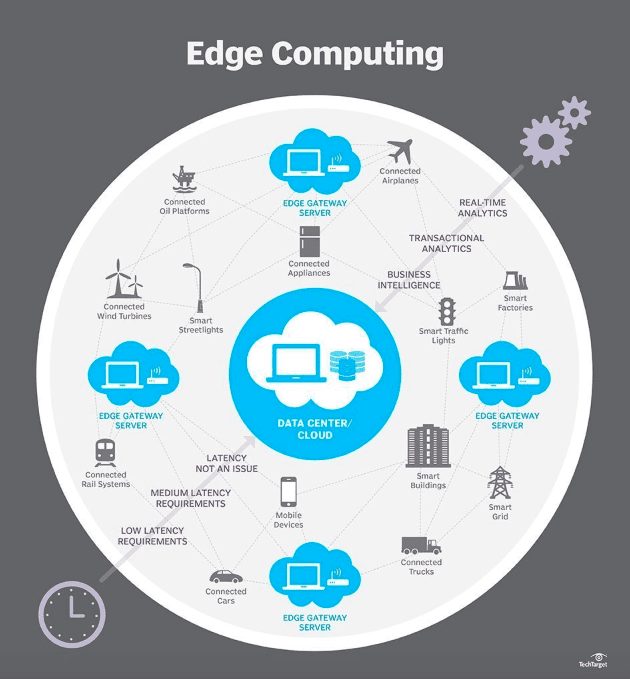In today’s demand driven world, there are two universal requests from internet users across the globe – more and faster. As organizations from a wide range of industries clamored for this, the edge was born.
So, what is the edge? Traditional data centers are located at the middle of a network. Now, significant processing can be completed at smaller local sites which are effectively at the edge of the network. As the amount of data being sent to and through networks continues to grow, organizations are processing data closer to where it’s generated – the network’s edge.
How Edge Computing Works
Edge computing is all about location. It eliminates the need for data to be sent across long routes to data centers and clouds. Ultimately it is shifting processing power out of the data center and closer to end users.
IoT devices transfer data to a local connection point. Once the data has been processed on the edge, just a portion or all of that information is then sent to a data repository located within the cloud, at a co-location facility or corporate data center.
For over a decade, the standard IT delivery platform has been considered centralized cloud computing. However, with new applications, workload services are demanding an architecture that is built to support a distributed infrastructure – enter in the age of edge computing.

Benefits of Edge Computing
The top 3 reasons edge computing will positively impact your organization:
Latency
By 2020, it’s predicted that the amount of traffic running through cloud computing networks will increase to 14.1 zettabytes per year.[1] End users want an instant response from applications and services, however spikes in traffic cause latency which can negatively affect their experience. The better the network quality – the better end user experience. Due to entertainment services like Netflix, over 70% of total bandwidth of internet usage is taken up by video streaming, with high bandwidth consumption. When large amounts of data are transmitted, everything is slowed down. [2] Edge computing provides more throughput and capacity by storing and processing data closer to where it’s used. This minimizes the network load in areas where network connectivity is low, enabling faster transmission and a better overall experience.
Security
Yes, there are some potential concerns with the level of security at the edge. IoT devices collect sensitive data and the local infrastructure must be configured with this in mind. Care must be taken that security is treated as seriously at the edge as it has historically been at the data center. So long as encryption is handled appropriately, there is an argument that decentralizing the data processing may improve security for your organization, as there is no singular “point of failure”.
Costs
Edge computing can lower costs by reducing the amount of times your organization has to copy large amounts of data from one system to another and then have to process and analyze it. Storing data and downloading it can be expensive and the more data that is transferred means having to pay higher bandwidth costs.
Edge Computing in the Real World
In IoT use cases, edge devices collect data which is then sent for processing either within a cloud storage repository, which is off-premise, or central data center, which is on-premise. Edge computing reduces backhaul traffic by processing some of that data locally. This is helpful in many different industries. The below image from TechTarget is a good depiction of how all these systems and devices are connected.
Healthcare
IoT devices within hospitals, like pacemakers, are constantly collecting patient data. Using field gateways, edge computing filters and analyzes the data before it’s further reviewed in the cloud. This gateway device can then send alerts and detect issues that may arise and need less latency than if the data were transferred directly to the cloud.
Chemical and Manufacturing
For chemical and manufacturing companies, many IoT monitoring devices are deployed as a safeguard. Devices such as temperature and moisture sensors produce large amounts of data. Edge computing allows this data to be analyzed, processed and delivered in real-time, enabling control centers to access data as it occurs to prevent any malfunctions or incidents.
Traffic Management
IoT devices are one of the main building blocks when it comes to traffic management. Edge computing analyzes and processes data from the traffic hardware and filters out anything not needed to help remove unnecessary traffic. This reduces the amount of data being transmitted and reduces operational costs.
Intelligent transportation systems allow driverless vehicles to host artificial intelligence applications at the network edge. This helps to ensure low latency levels which is critical to provide the data needed to run the vehicle.
Edge computing enables organizations to improve experience, scale to large number of distributed sites and provide consistency with unreliable networks.
From reducing costs to providing a better user experience, edge computing allows for consistency between services and devices being run in the cloud which makes it a smart solution for organizations.
Want more information on edge computing? Please see:
Edge Computing – the New Frontier of Web
Computing on the Fringes, How Edge Computing and Fog Computing are Changing the Way we See IoT
[1] https://www.cloudcomputing-news.net/news/2016/nov/14/cisco-argues-global-cloud-traffic-hit-14-zb-2020-latest-study/ [2] https://www.pcworld.com/article/3012625/streaming-services/video-audio-streaming-gobble-up-70-of-peak-internet-traffic-in-north-america.html





